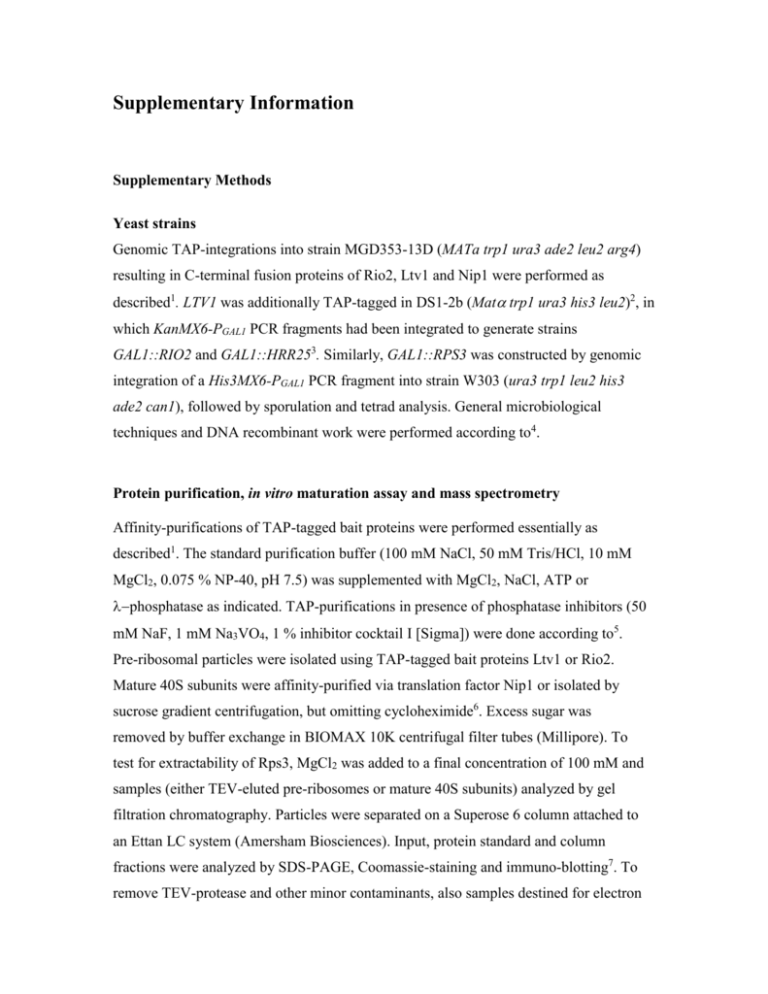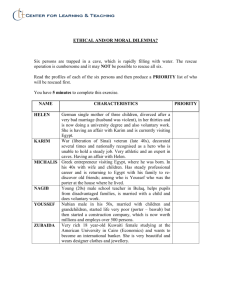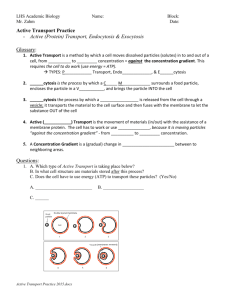Supplementary Methods
advertisement

Supplementary Information Supplementary Methods Yeast strains Genomic TAP-integrations into strain MGD353-13D (MATa trp1 ura3 ade2 leu2 arg4) resulting in C-terminal fusion proteins of Rio2, Ltv1 and Nip1 were performed as described1. LTV1 was additionally TAP-tagged in DS1-2b (Mat trp1 ura3 his3 leu2)2, in which KanMX6-PGAL1 PCR fragments had been integrated to generate strains GAL1::RIO2 and GAL1::HRR253. Similarly, GAL1::RPS3 was constructed by genomic integration of a His3MX6-PGAL1 PCR fragment into strain W303 (ura3 trp1 leu2 his3 ade2 can1), followed by sporulation and tetrad analysis. General microbiological techniques and DNA recombinant work were performed according to4. Protein purification, in vitro maturation assay and mass spectrometry Affinity-purifications of TAP-tagged bait proteins were performed essentially as described1. The standard purification buffer (100 mM NaCl, 50 mM Tris/HCl, 10 mM MgCl2, 0.075 % NP-40, pH 7.5) was supplemented with MgCl2, NaCl, ATP or phosphatase as indicated. TAP-purifications in presence of phosphatase inhibitors (50 mM NaF, 1 mM Na3VO4, 1 % inhibitor cocktail I [Sigma]) were done according to5. Pre-ribosomal particles were isolated using TAP-tagged bait proteins Ltv1 or Rio2. Mature 40S subunits were affinity-purified via translation factor Nip1 or isolated by sucrose gradient centrifugation, but omitting cycloheximide6. Excess sugar was removed by buffer exchange in BIOMAX 10K centrifugal filter tubes (Millipore). To test for extractability of Rps3, MgCl2 was added to a final concentration of 100 mM and samples (either TEV-eluted pre-ribosomes or mature 40S subunits) analyzed by gel filtration chromatography. Particles were separated on a Superose 6 column attached to an Ettan LC system (Amersham Biosciences). Input, protein standard and column fractions were analyzed by SDS-PAGE, Coomassie-staining and immuno-blotting7. To remove TEV-protease and other minor contaminants, also samples destined for electron microscopy were subjected to gel filtration chromatography under standardized conditions (100 mM NaCl, 50 mM Tris/HCl, 10 mM MgCl2, 0.5 mM DTT, pH 7.5). 40S or pre-40S peak fractions were subsequently analyzed by negative staining EM or cryo-electron microscopy (see below). In vitro phosphorylation of pre-ribosomal complexes was initially performed during IgG-binding (Fig. 3a). Immobilized samples were incubated in presence of 1 mM ATP for 30 min at either 4 or 30 °C. At physiological temperature, this protocol did not allow for recovery of bait protein Ltv1. Further phosphorylation studies were therefore conducted with TEV-eluted pre-ribosomes. For in vitro maturation, affinity purified particles were first incubated in presence of 1 mM ATP ([Sigma], 30 min at 30 °C), before excess phosphatase (-PP [NEB], 400 U / 100 µl of sample, 30 min at 30 °C) was added. For negative control, either the first or the second incubation was conducted in mock buffer (100 mM NaCl, 50 mM Tris/HCl, 10 mM MgCl2, 0.5 mM DTT, pH 7.5). MS analysis of Coomassie-stained protein bands was performed as described6. For detection of phosphopeptides, gel extracts were analyzed by nanoflow LC-MS/MS on a Q-Star Pulsar quadrupole time-of-flight tandem mass spectrometer (AB/MDSSciex). MS/MS spectra were searched against the MSDB protein database using the MASCOT algorithm. Search parameters included a differential modification of +80 Da on serine, threonine and tyrosine residues. RNA analysis RNA analysis was performed as described8. Oligonucleotides used for primer extension and Northern hybridization were: 003: 5'-TGT TAC CTC TGG GCC C-3' 004: 5'-CGG TTT TAA TTG TCC TA-3' 007: 5'-CTC CGC TTA TTG ATA TGC-3' 008: 5'-CAT GGC TTA ATC TTT GAG AC-3' 020: 5'-TGA GAA GGA AAT GAC GCT-3' 033: 5'-CGC TGC TCA CCA ATG G-3' 200: 5'-UUA UGG GAC UUG UU-3' Negative staining electron microscopy and image processing For negative staining EM, a 5 µl droplet of pre-40S or mature 40S subunit (as derived from gel filtration chromatography) was applied on a glow discharged carbon/parlodioncoated 200-mesh copper EM grid. After 1 min incubation excess suspension was removed by blotting with filter paper, three times washed on clean water droplets, and negatively stained with 2 % aqueous uranyl acetate (Fluka, Switzerland) for 45 sec. Images were recorded at 50,000x magnification on an EM912 Omega EFTEM (LEO Electron microscopy, Oberkochen, Germany) operated at an acceleration voltage of 120 kV, equipped with a slow-scan CCD camera with a 2 MHz read out, 16 bit depth, 1024 1024 pixel CCD chip (pixel size 19 µm) and a P43 phosphorus scintillator (Proscan, Scheuring, Germany). 2D averaging was carried out using the EMAN image processing software package9 run on a Linux Mandrake 9.2 desktop PC. 1509 mature 40S ribosomes, 1269 pre-40S ribosomal particles, and 1375 particles from the phosphorylation/dephosphorylation treatment were boxed and both angularly and translationally aligned to the arbitrary reference particle as well as to its mirror image at correlation factors (keep values) of 0.1 to 1.0. Repeated correlation cycles (8 iterations) yielded the shown final averages (CLASSALIGN2 command in EMAN). Reference free classification within the EMAN package (STARTNRCLASSES) was employed to separate particles to classes. From the final averages calculated in EMAN, electron density contour maps were generated using the SEMPER image processing system run on a DEC VAX workstation 4000-600. Cryo-electron microscopy and image processing Perforated carbon coated grids were glow discharged in air for 1 min and used within the next 60 min. Pre-40S and 40S particles (2 µl, 0.25 mg/ml – 1 mg/ml) were applied to the pre-treated grids. Grids were mounted into a controlled environment freezing apparatus10. After blotting for 15 s with two layers of filter paper (Whatman No 1) at room temperature, the grid was plunged into liquid ethane. Grids were transferred to a Philips CM200 FEG electron microscope using a Gatan 626 cryo transfer holder. Micrographs were recorded under low dose conditions on a 2K x 2K Tietz-CCD camera (TVIPS F224) at 200 kV with a nominal magnification of 50,000x (calibrated pixel size 2.86 A/pixel). Particles were selected interactively (4129 particle images of pre-40S ribosome; 4827 particle images of mature 40S ribosome) and boxed with a box-size of 160 x 160 pixels using the MRC-software package11. The defocus of each micrograph was determined using CTFFIND212. Individual particle images were corrected for the contrast transfer function (CTF) by dividing by the CTF (CTFAPPLYA of the MRC-package) and allowing a minimal denominator of 0.7. Further processing of the CTF-corrected particle images was done with the IMAGIC 5 software package13. Particle images were band-pass filtered (low frequency cut-off 0.01, high frequency cut-off 0.8) and normalized in their grey value distribution. In order to speed up further processing, two by two pixels were binned. Particle images were centered and classified (alignment by classification14). Class-averages with well-defined shape and outline were used as references in further multi-reference-alignment. This process was repeated iteratively until stable classaverages were obtained. For the initial determination of Euler angles for selected class averages, we followed the concept outlined in15. Class averages were oriented with their long molecule axis parallel to the vertical image axis. We assumed that class averages with the same maximal dimension in the long direction, varied only by the rotation around the long axis. This rotational angle was estimated by the relative position of several protruding features (beak, shoulder, positions of the two protrusions at the bottom). Class-averages were back-projected to an initial three-dimensional model using the determined Euler angles. For further iterative refinement we used a combination of classification and projections matching. (1) All particle images were aligned by multi-reference alignment to a set of references generated by projecting the current best 3D-map. (2) Aligned particle images were classified using MSA. Processing was continued with those particle images which gave class-averages with well-defined shape. This step was skipped in later rounds of refinement. (3) Particle images (selected in step 2 or all when step 2 was skipped) were classified and (4) class averages were calculated. (5) For class averages with defined outline and shape, Euler angles were determined by projection matching to projections of the current best 3D-map. (6) The 3D-map was reconstructed from class- averages by weighted back-projection. The map was truncated by a Gaussian-filter to Fourier-spacing where the Fourier-shell correlation (between two maps each calculated from half of the data) cut the 3-curve of significance. Steps 1-6 were repeated until no further improvement occurred. In the final maps approximately 30-40 % of the original particle images were included. The resolution of the final maps was estimated using Fourier-Shell-Correlation. For the pre-40S ribosome the Fourier-Shell-Correlation was 0.5 at Fourier spacing of 1/33 Å-1 and cut the 3-curve of significance at 1/20 Å-1. For the mature 40S subunits, the Fourier-shell correlation dropped to 0.5 at a Fourier spacing of 1/31 Å-1 and cut the 3-curve of significance at 1/20 Å-1. Supplementary References 1. Puig, O. et al. The tandem affinity purification (TAP) method: a general procedure of protein complex purification. Methods 24, 218-229 (2001). 2. Nissan, T. A., Baßler, J., Petfalski, E., Tollervey, D. & Hurt, E. 60S pre-ribosome formation viewed from assembly in the nucleolus until export to the cytoplasm. EMBO J. 21, 5539-5547 (2002). 3. Longtine, M.S. et al. Additional modules for versatile and economical PCR-based gene deletion and modification in Saccharomyces cerevisiae. Yeast 14, 953-961 (1998). 4. Maniatis, T., Fritsch, E. F. & Sambrook, J. Molecular cloning: a laboratory manual (Cold Spring Harbor Laboratory, Cold Spring Harbor, N.Y., 1982). 5. He, X. & Moore, C. Regulation of yeast mRNA 3' end processing by phosphorylation. Mol. Cell 19, 619-629 (2005). 6. Baßler, J. et al. Identification of a 60S preribosomal particle that is closely linked to nuclear export. Mol. Cell 8, 517-529 (2001). 7. Siniossoglou, S. et al. A novel complex of nucleoporins, which includes Sec13p and a Sec13p homolog, is essential for normal nuclear pores. Cell 84, 265-275 (1996). 8. Schäfer, T., Strauß, D., Petfalski, E., Tollervey, D. & Hurt, E. C. The path from nucleolar 90S to cytoplasmic 40S pre-ribosomes. EMBO J. 22, 1370-1380 (2003). 9. Ludtke, S. J., Baldwin, P. R. & Chiu, W. EMAN: semiautomated software for highresolution single-particle reconstructions. J. Struct. Biol. 128, 82-97 (1999). 10. Bellare, J. R., Davis, H. T., Scriven, L. E. & Talmon, Y. Controlled environment vitrification system: an improved sample preparation technique. J. Elec. Mic. Tech. 10, 87-111 (1988). 11. Crowther, R. A., Henderson, R. & Smith, J. M. MRC image processing programs. J. Struct. Biol. 116, 9-16 (1996). 12. Mindell, J. A. & Grigorieff, N. Accurate determination of local defocus and specimen tilt in electron microscopy. J. Struct. Biol. 142, 334-347 (2003). 13. van Heel, M., Harauz, G., Orlova, E. V., Schmidt, R. & Schatz, M. A new generation of the IMAGIC image processing system. J. Struct. Biol. 116, 17-24 (1996). 14. Dube, P., Tavares, P., Lurz, R. & van Heel, M. The portal protein of bacteriophage SPP1: a DNA pump with 13-fold symmetry. EMBO J. 12, 1303-1309 (1993). 15. Rubinstein, J. L., Walker, J. E. & Henderson, R. Structure of the mitochondrial ATP synthase by electron cryomicroscopy. EMBO J. 22, 6182-6192 (2003). Supplementary Figure Legends Supplementary Figure S1. Salt-resistant interaction of Rps3 and mature 40S subunits. Gel filtration profiles of 100mM MgCl2-treated mature 40S subunits isolated by either sucrose gradient centrifugation (a) or affinitypurification of translation initiation factor Nip1-TAP (b). Input (L), protein standard (S) and column fractions (1-17) were analyzed by SDS-PAGE/Coomassie staining, and Western blotting using anti-CBP (bait), anti-Rps3 and anti-Rps8 antibodies. 40S subunits elute between fatty acid synthetase (Fas1/2, ~2 MDa) and the 670 kDa marker. Rps3 co-peaks with 40S subunits. Supplementary Figure S2. Structural classification of 40S and pre-40S ribosomal subunits. a, Negative staining EM. I and IV, Overview pictures of negatively stained mature 40S subunits and pre-40S particles (upper panels) and galleries of selected single particles (lower panels). II and V, Characteristic classes of mature 40S and pre-40S particles obtained by reference free classification using EMAN. Purple rectangles indicate the particular calculation and the number of particles averaged per class. III and VI, Final projection averages of mature 40S and pre-40S particles (upper panels) and respective electron density contour maps (lower panels). Depending on the correlation factor (keep value) set the indicated number of particles was considered for calculation. b, Cryo-EM. I, Selected class averages of side views of mature 40S and pre-40S particles. 30-50 single images were averaged per class. Note that the beak RNA may adopt different orientations. II and III, surface representations of 3D-reconstructed 40S and pre-40S particles. Depicted are 20° freeze images of left-handed rotations along the longitudinal axes. Fully animated rotations of 40S and pre-40S particles are provided as Supplementary data and can also be downloaded from the EMBL-EBI Molecular Structure Database (http://www.ebi.ac.uk/msd/). Accession numbers EMD-1211 (pre-40S ribosome) and EMD-1212 (mature 40S subunit). Supplementary Figure S3. Rps3 depletion blocks 40S biogenesis. a, Repression of RPS3 causes growth arrest. Wild-type (wt) and GAL1::RPS3 strain were grown on galactose- (YPGal) or glucose-containing plates (YPGlu). b, Analysis of rRNA processing defects in the GAL1::RPS3 strain. Wild-type (wt) and Rps3 depletion mutant were grown in galactose medium and shifted to glucose medium for up to 6 hours. In intervals total RNA was extracted and hybridized with the RNA-probes indicated on the left. Assayed rRNA species are labeled on the right. c, Repression of RPS3 induces nuclear accumulation of the 40S subunit reporter Rps2-GFP. Strain GAL1::RPS3 expressing either Rps2GFP or Rpl25-GFP was grown in YPGal or YPGlu medium for 4 hours. The location of the reporters was analyzed by fluorescence microscopy. d, Sucrose gradient centrifugation of cell lysates derived from indicated strains grown in either YPGal or shifted to YPGlu for 4 hours. Ribosomal fractions (40S, 60S, 80S and polysomes) were determined by UV-measurement at 254 nm. Rps3depleted cells have reduced levels of 40S subunits. Supplementary Figure S4. In vivo and in vitro phosphorylation of Ltv1 and Enp1. a, Pre-40S particles contain phosphorylated Ltv1 and Enp1. Ltv1-TAP was affinity-purified from yeast lysates in the absence (-) or presence (+) of phosphatase (PPase) inhibitors. TEV-eluates were analyzed by SDS-PAGE and Coomassie staining. In the presenece of phosphatase inhibitors, Ltv1 and Enp1 migrate slower on the SDS-polyacrylamide gel. Phosphorylation of Ltv1 (Ltv1~P) and Enp1 (Enp1~P) is indicated with arrows. b, ATP induces in vitro phosphorylation and band shifts of Ltv1, Enp1 and Rps3. Comparison of fractions #5 (no ATP; see Fig. 3c) and #11 (+ ATP, see Fig. 3b) from the corresponding gel filtrations. Depending on presence or absence of ATP, Ltv1, Enp1 and Rps3 migrate differently in SDS-polyacrylamide gels. Mass spectrometry of the shifted bands identified several phosphopeptides, suggesting that Enp1 is modified at least on serine 81 and 152, Ltv1 on serine 57, 281, 397, 433 and 459, and Rsp3 on threonine 207 and serine 221. Supplementary Figure S5. Neither phosphorylation nor dephosphorylation alone induce 40S subunit maturation Pre-ribosomal particles were affinitypurified via bait protein Rio2-TAP. TEV-eluates were either incubated in presence of ATP and then shifted to mock buffer (a), or first incubated in mock b). Each incubation step lasted 30 min at 30 °C. Samples were subsequently analyzed by gel filtration under high-salt conditions (100 mM MgCl2), followed by SDS-PAGE/Coomassie staining, and Western blotting using anti-Rps3 antibodies. Input (L); protein standard (S); column fractions (1-27); TEV-protease (asterisks); -phosphatase (open circle); band 1, Ltv1; band 2, Enp1. Supplementary Figure S6. Repression of Hrr25 inhibits formation and nuclear export of 40S subunits. a, Growth properties of wild-type (wt) and GAL1::HRR25 strains on galactose- (YPGal) or glucose-containing plates (YPGlu). b, Analysis of rRNA processing defects in the GAL1::HRR25 strain. Strains were grown in galactose medium and shifted to glucose medium for up to 24 hours. Total RNA was extracted at indicated times and hybridized with oligonucleotides labeled on the left. Assayed rRNA species are indicated on the right. c, Repression of HRR25 induces nuclear accumulation of pre-40S subunits. Strain GAL1::HRR25 expressing either Rps2-GFP or Rpl25-GFP was grown in galactose- or glucose-containing medium for 4 hours. The subcellular location of the reporters was analyzed by fluorescence microscopy. Supplementary Figure 7. Repression of RIO2 does not affect ATP-induced phosphorylation of Ltv1, Enp1 and Rps3 in isolated pre-40S particles. a, Repression of RIO2 causes growth arrest. Wild-type (wt) and GAL1::RIO2 strains were grown on galactose- (YPGal) or glucose-containing plates (YPGlu). b, Affinity-purification of TAP-tagged Ltv1 from GAL1::RIO2 (left panel) and GAL1::HA-RIO2 cells (right panel) grown for 12 hours in either galactose(YPGal) or glucose-containing medium (YPGlu). No ATP (-) or 1 mM ATP (+) was added to induce in vitro phosphorylation. TEV-eluates were analyzed by SDS-PAGE and Coomassie staining or where indicated by Western blotting using anti-HA antibodies. ATP-induced band shifts of Ltv1, Enp1 and Rps3 are indicated with arrows. Indicated by an asterisk is an IgG contamination from the beads. In this band also residual Rio2 was detected. Depletion of Rio2 was independently verified by Western analysis, testing for the loss of HA-Rio2 in the Ltv1-TAP preparation. c, Phosphorylation and dissociation of Ltv1, Enp1 and Rps3 in Rio2-depleted cells. Ltv1-TAP purification from GAL1::RIO2 (upper panel) and GAL1::HA-RIO2 cells (lower panel) grown for the indicated time in YPGlu. The TEV-eluates were incubated for 30 min at 30 °C with 1 mM ATP before gel filtration chromatography. Input (L), protein standard (S) and fractions (1-27) from the column were analyzed by SDS-PAGE or Western blotting using anti-Rps3 antibodies. Band 1, Ltv1; band 2, Enp1; band 3, Rps3.








